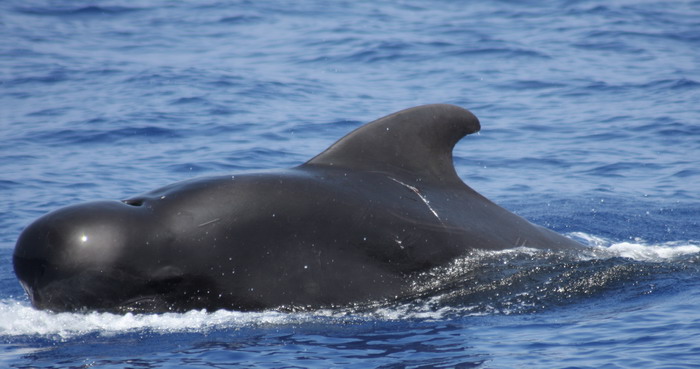- Home
- Accommodation
- Activities
- Area Info
- Maps
- Photo Galleries
- Real Estate
- Travel
Pilot Whales
Along with countless marine creatures such as white-tip reef sharks, octopuses, fish, eels, nudibranchs and rays, there are plenty of cetaceans in the ocean bordering Montezuma, and pilot whales are one of them. Pilot whales are the second largest member of oceanic dolphins, only being surpassed by Orca whales.
The pilot whale is in the cetacean genus Globicephala and is also known as blackfish. The name ‘pilot’ is derived from a belief that the pods of these whales are leaded by a certain whale. There are two present species of the pilot whale known as long-finned pilot whale and short-finned pilot whale. The long-finned pilot whales (or G. Melas) are found worldwide in temperate waters and the short-finned pilot whales (or G. macrorhynchus) are globally present in tropical and subtropical waters. The differences between the two types are related to their number of teeth and the length of the pectoral fins. Otherwise, the distinction can only be made through an analysis of their skulls. The bodies of pilot whales are the dark shades of grey, black or brown. There are few lighter patches on the body like on the saddle pitch behind the dorsal fins, an anchor shaped pattern under the chin, and also behind the eyes, genital areas and on the belly. The dorsal fins are placed on the back, they are set forward and sweeps rearward. They have a sickle shaped flippers and a flattened tail stock. When compared to other whales, pilot whales have a sturdy body than others. The melon, an ovoid fatty body part on the forehead of the whales which help in echolocation, is generally more bulbous and fleshy. The length of a male pilot whale is 7.2 meters and in females it is about 5.5 meters. Males are also heavier, with a weigh of 3,200.
The lifespan of pilot whales in the wild is 60 years for females and in 45 years for males. They live in large pods, with up to 100 whales in a group. Pilot whales prefer to feed on squid, but they also prey on fish and smaller species. Coming on to reproduction, the female pilot whales mature earlier than males. They mature at the age of seven while males mature around 12 years of age. Their calves are sixfeet long at birth and weigh only 200 pounds or so. For two years, the mother whales nurture their kids. Pilot whales usually dwell in deeper waters, and are known to be intelligent and social, which is why they are quite easy to train. Pilot whales get stranded the most of all the cetaceans, and as they live in close groups, the whole pods can get beached.
Pilot Whales in Montezuma
Pilot whales can be seen in the waters surrounding Montezuma and the nearby regions. In the town, the two dive sites, popular for whale watching, are Playa las Manchas and Playa las Rocas. Cabo Blanco Marine Reserve is a protected national park with superb beaches, dive points and snorkel spots. It is a splendid place to view pilot whales along with plenty of other animals. Cabuya Island is on the southern Nicoya Peninsula, a drive away from the town Montezuma. The island is an active cemetery, and also has a few great diving places. Ride a boat to Tortuga Island and snorkel with the dolphins, whales, octopuses and fish. Also in Puntarenas is Tambor Bay, a horse-shoe shaped bay with popular dive points; Los Muertos, La Chanchito and La Chancha.
References:
http://en.wikipedia.org/wiki/Globicephala#cite_note-Perrin-7
http://www.goodmorningpavones.com/2011/04/pavones-whales-pilot-humpback-costa.html
Great Stuff

Clandestina Restaurant
My new favorite restaurant, Clandestina is not to be missed by food lovers staying anywhere near to Montezuma. Established in March 2015, Clandestina is the new kid on the block. The Oregon/Tico collaboration is a winner among locals and travelers alike, with artisan craft beers, made onsite by Butterfly Brewing Co. and delicious, exciting […]












